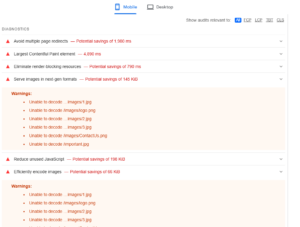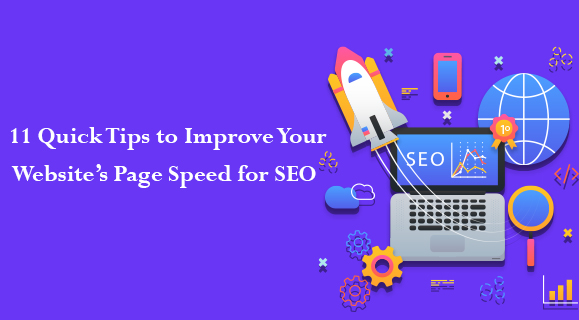Introduction
Website speed is a crucial factor for both user experience and SEO. Google considers page speed as a ranking factor, and slow-loading websites can negatively impact search rankings, increase bounce rates, and lower conversions. Implementing quick tips to improve SEO can help optimize your site’s performance and boost rankings.
If your site takes more than 3 seconds to load, you risk losing visitors. But don’t worry! In this guide, we’ll cover 11 quick and effective ways to boost your website’s speed for better performance and higher rankings.
Optimize Images
Why It Matters:
Large images slow down your site significantly. Optimized images improve loading speed without sacrificing quality.
How to Fix:
- Use compressed image formats like WebP, JPEG, and AVIF.
- Use tools like TinyPNG, ShortPixel, or ImageOptim to reduce image size.
- Implement lazy loading (
loading="lazy") to delay offscreen images from loading.
📌 Insert an image showing a compressed vs. uncompressed image file.
Enable Browser Caching
Why It Matters:
Caching stores website files in visitors’ browsers so they don’t have to reload everything each time they visit.
How to Fix:
- Add cache expiration headers in
.htaccess. - Use a caching plugin like WP Rocket, W3 Total Cache, or LiteSpeed Cache (for WordPress).
📌 Insert an image showing browser caching in action.
Minify CSS, JavaScript & HTML

Why It Matters:
Unnecessary spaces, comments, and code bloating slow down website performance.
How to Fix:
- Minify code using tools like MinifyCode, CSSNano, or JSCompress.
- Enable Gzip compression in your hosting panel.
📌 Insert an image of minified vs. unminified code.
Use a Content Delivery Network (CDN)
Why It Matters:
A CDN distributes your website content across multiple global servers, reducing the time it takes for users to access your site.
How to Fix:
- Use Cloudflare, StackPath, or Amazon CloudFront for CDN services.
- Enable caching and CDN integration in your hosting settings.
📌 Insert an image explaining how a CDN works.
Reduce HTTP Requests
Why It Matters:
Every request made to your server slows down page loading time. Reducing these requests speeds up your site.
How to Fix:
- Combine CSS and JavaScript files.
- Remove unnecessary external scripts (fonts, ads, analytics).
- Enable async or defer loading for JavaScript files.
📌 Insert an image showing reduced vs. excessive HTTP requests.
Optimize Server Response Time
Why It Matters:
A slow server response increases load time, affecting user experience and SEO.
How to Fix:
- Choose a reliable hosting provider (like SiteGround, Bluehost, or Cloudways).
- Upgrade to a faster server, VPS, or cloud hosting.
- Monitor response time with Google PageSpeed Insights.
📌 Insert an image of a slow vs. fast server response graph.
Enable Gzip Compression
Why It Matters:
Gzip reduces file sizes, allowing faster transfers between the server and the user’s browser.
How to Fix:
- Enable Gzip compression in
.htaccess(Apache) ornginx.conf(Nginx). - Use plugins like WP Rocket (for WordPress) to enable compression.
📌 Insert an image demonstrating the compression ratio with and without Gzip.
Implement Lazy Loading for Videos & Images
Why It Matters:
Lazy loading delays the loading of media until a user scrolls down to view it, reducing initial page load time.
How to Fix:
- Add
loading="lazy"to<img>and<iframe>elements. - Use WordPress plugins like Lazy Load by WP Rocket.
📌 Insert an image explaining lazy loading.
Remove Unused Plugins & Scripts
Why It Matters:
Too many plugins and scripts create unnecessary overhead, slowing your site.
How to Fix:
- Audit your plugins and remove any that are not essential.
- Replace heavy plugins with lightweight alternatives.
- Limit the use of third-party tracking codes.
📌 Insert an image showing a before/after plugin cleanup.
Optimize Database Performance
Why It Matters:
A cluttered database can slow down your website’s back-end operations.
How to Fix:
- Use WP-Optimize or WP-Sweep to clean database junk.
- Regularly delete old revisions, spam comments, and expired transients.
- Optimize MySQL databases using phpMyAdmin.
📌 Insert an image of database optimization settings.
Use Accelerated Mobile Pages (AMP)
Why It Matters:
AMP loads pages faster on mobile devices, improving mobile SEO rankings.
How to Fix:
- Use the AMP plugin (for WordPress).
- Follow Google’s AMP HTML guidelines.
- Test AMP pages with Google’s AMP Validator.
📌 Insert an image comparing AMP vs. non-AMP mobile pages.
Conclusion
Improving page speed is crucial for SEO and user experience. By implementing these 11 tips, you can ensure your site loads faster, improves engagement, and ranks higher on Google.
- Test your website’s speed with Google PageSpeed Insights.
- Start optimizing today and share your improvements with us!
FAQs
1. Why is page speed important for SEO?
Page speed is a Google ranking factor that directly affects user experience, conversion rates, and search rankings.
2. How can I check my website’s page speed?
Use tools like Google PageSpeed Insights, GTmetrix, or Lighthouse to analyze and improve speed.
3. Does a slow website affect SEO rankings?
Yes! Slow-loading websites have higher bounce rates, lower rankings, and reduced conversions.
4. Can a CDN improve website speed?
Absolutely! A CDN reduces latency by serving content from the closest server to the visitor’s location.
5. What is the best way to optimize images for speed?
Use compressed formats like WebP and tools like TinyPNG, ShortPixel, or Imagify.
Final Call to Action
Found these tips useful? Share this guide and comment below if you need more speed optimization advice!

Leave a Reply